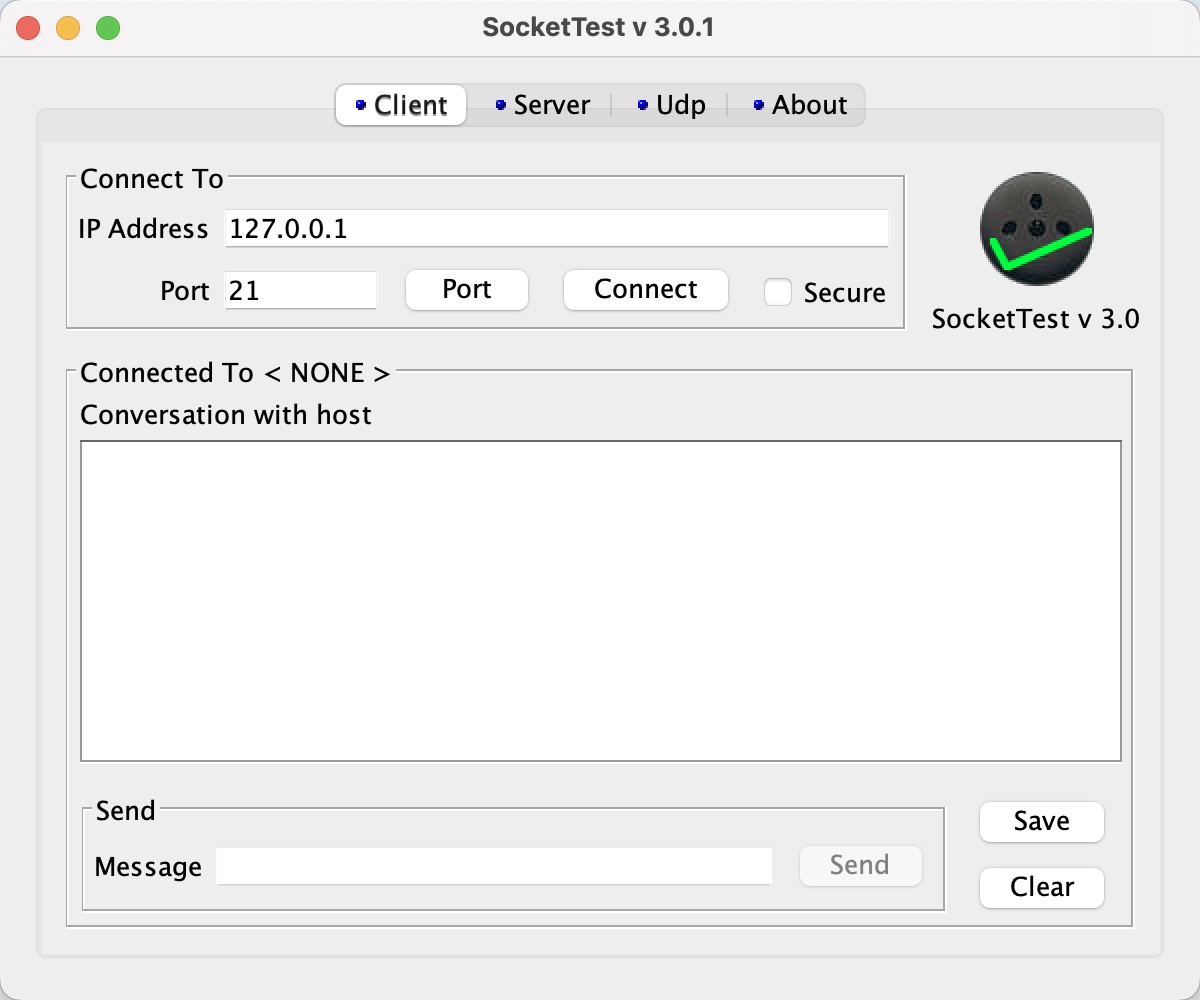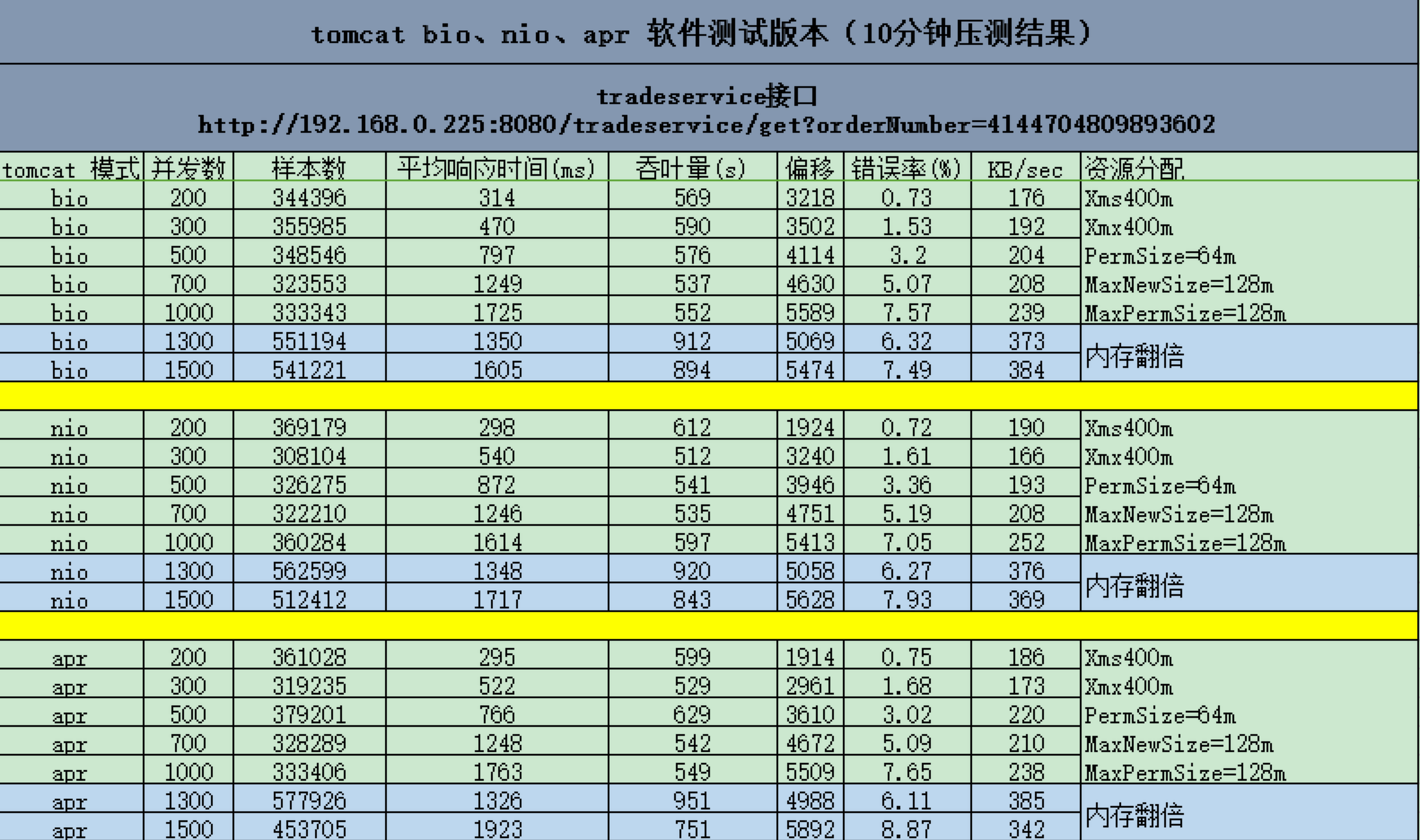理解tomcat中的BIO、NIO、AIO、ARP
tomcat作为springboot中默认的web容器,了解tomcat的运转可以帮助我们更好的去调整tomcat的参数达到更好的性能
1. 前置知识
- I/O就是Input/Output,收别人的数据到本机叫Input,本级发数据出去叫Output
- 网络I/O请求会先到网卡然后到内核态再到用户态
- CPU比内存快、内存比硬盘、网卡等外设快
- 所有I/O操作需要被加载到用户态内存,用户态程序才能直接操作
- 想要效果高,必须让所有的资源都不闲置
- tomcat不处理请求,会接受请求,转发到具体的容器中
- 一个socket连接代表一个客户端,一个socket可以发送多份请求不断开
2. scoket测试工具
启动程序是jar包,必须要有jre环境
链接:https://sockettest.sourceforge.net

3. BIO 同步阻塞IO
每一个socket连接后,tomcat都会有一个线程去全程去陪伴,把请求转发到具体的容器中后,这个线程还在阻塞,等待容器返回数据,只有socket连接断开了,才会回收这个线程。tomcat7或以下默认,比较简单、稳定,适合连接数比较少的
模拟代码如下:
java
public class BioServer {
static ExecutorService executorService = Executors.newCachedThreadPool();
public static void main(String[] args) {
try {
// 启动服务,绑定8080端口
ServerSocket serverSocket = new ServerSocket();
serverSocket.bind(new InetSocketAddress(8080));
System.out.println("开启服务");
while (true){
System.out.println("等待客户端建立连接");
// 监听8080端口,获取客户端连接
Socket socket = serverSocket.accept(); //阻塞
System.out.println("建立连接:"+socket);
executorService.submit(()->{
//业务处理
try {
handler(socket);
} catch (IOException e) {
e.printStackTrace();
}
});
}
} catch (IOException e) {
e.printStackTrace();
} finally {
//TODO 资源回收
}
}
private static void handler(Socket socket) throws IOException {
byte[] bytes = new byte[1024];
System.out.println("等待读取数据");
int read = socket.getInputStream().read(bytes); // 阻塞
if(read !=-1) {
System.out.println("读取客户端发送的数据:" +
new String(bytes, 0, read));
}
}
}4. NIO 同步非阻塞
一个socket连接过来,会经历以下步骤
- LimitLatch:连接控制器,负责维护连接数计算,连接数默认是 8192,达到这个阀值后,就会拒绝连接请求。如果要调整修改配置文件server.tomcat.max-connections属性
- Acceptor:Acceptor 跑在一个单独的线程里,它在一个死循环里调用 accept 方法来接收新连接,一旦有新的连接请求到来,accept 方法返回一个 Channel 对象,接着把 Channel 对象交给 Poller 去处理
- Poller:Poller 的本质是一个 Selector,也跑在单独线程里。Poller 在内部维护一个 Channel 数组,它在一个死循环里不断检测 Channel 的数据就绪状态,一旦有 Channel 可读,就生成一个 SocketProcessor 任务对象扔给Executor 去处理
- Executor: Executor 就是线程池,负责运行 SocketProcessor 任务类,SocketProcessor 的 run 方法会调用Http11Processor 来读取和解析请求数据。Http11Processor 是应用层协议的封装,它会调用容器获得响应,再把响应通过 Channel 写出

tomcat8及以上默认, springboot2.3.12.RELEASE内嵌tomcat是9.0.46版本默认也是这个
模拟代码:
public class NioServer {
public static void main(String[] args) {
List<SocketChannel> list = new ArrayList<>(); // 缓存所有的socket
ByteBuffer byteBuffer = ByteBuffer.allocate(1024); // 缓存区的大小
try {
ServerSocketChannel serverSocketChannel = ServerSocketChannel.open();
// 监听8080
serverSocketChannel.bind(new InetSocketAddress(8080));
// channel非阻塞
serverSocketChannel.configureBlocking(false);
System.out.println("NioServer 启动....");
while (true){
// 非阻塞
SocketChannel socketChannel = serverSocketChannel.accept();
Thread.sleep(1000);
if(socketChannel == null){
System.out.println("没有新的客户端建立连接");
}else {
System.out.println("新的客户端建立连接");
// channel非阻塞
socketChannel.configureBlocking(false);
// 将新的socket添加到 list
list.add(socketChannel);
}
//遍历所有的socket
for(SocketChannel channel:list){
//非阻塞
int read = channel.read(byteBuffer);
if(read >0) {
//读模式
byteBuffer.flip();
System.out.println("读取客户端发送的数据:" +new String(byteBuffer.array(),0,read));
byteBuffer.clear();
}
}
}
} catch (Exception e) {
e.printStackTrace();
}
}
}5. AIO异步非阻塞
NIO 和 AIO(NIO2) 最大的区别是,一个是同步一个是异步。异步最大的特点是,应用程序不需要自己去触发数据从内核空间到用户空间的拷贝。

没有 Poller 组件,也就是没有 Selector。在异步 I/O 模式下,Selector 的工作交给
内核来做了。
Linux 内核没有很完善地支持异步 I/O 模型,因此 JVM 并没有采用原生的 Linux 异步 I/O,而是在应用层面通过 epoll 模拟了异步 I/O 模型。因此在 Linux 平台上,Java NIO 和 Java NIO2 底层都是通过 epoll 来实现的,但是 Java NIO 更加简单高效。如果你的 Tomcat 跑在 Linux 平台上,建议不使用NIO2
模拟代码:
public class AioServer {
public AsynchronousServerSocketChannel serverSocketChannel;
public static void main(String[] args) throws Exception {
new AioServer().listen();
Thread.sleep(Integer.MAX_VALUE);
}
private void listen() throws IOException {
//1. 创建一个线程池
ExecutorService es = Executors.newCachedThreadPool();
//2. 创建异步通道群组
AsynchronousChannelGroup acg = AsynchronousChannelGroup.withCachedThreadPool(es, 1);
//3. 创建服务端异步通道
serverSocketChannel = AsynchronousServerSocketChannel.open(acg);
//4. 绑定监听端口
serverSocketChannel.bind(new InetSocketAddress(8080));
System.out.println("AioServer 启动....");
//5. 监听连接,传入回调类处理连接请求
serverSocketChannel.accept(this, new CompletionHandler<AsynchronousSocketChannel, AioServer>() {
//
// //具体处理连接请求的就是completed方法,它有两个参数:第一个是异步通道,第二个就是上面传入的AioServer对象
@Override
public void completed(AsynchronousSocketChannel socketChannel, AioServer attachment) {
try {
if (socketChannel.isOpen()) {
System.out.println("接收到新的客户端的连接,地址:"
+ socketChannel.getRemoteAddress());
final ByteBuffer byteBuffer = ByteBuffer.allocate(1024);
//调用 read 函数读取客户端发送的数据
socketChannel.read(byteBuffer, socketChannel,
new CompletionHandler<Integer, AsynchronousSocketChannel>() {
@Override
public void completed(Integer result, AsynchronousSocketChannel attachment) {
try {
//读取请求,处理客户端发送的数据
byteBuffer.flip();
String content = Charset.defaultCharset()
.newDecoder().decode(byteBuffer).toString();
System.out.println("服务端接受到客户端发来的数据:" + content);
} catch (CharacterCodingException e) {
e.printStackTrace();
}
}
@Override
public void failed(Throwable exc, AsynchronousSocketChannel attachment) {
exc.printStackTrace();
try {
attachment.close();
} catch (IOException e) {
e.printStackTrace();
}
}
});
}
} catch (IOException e) {
e.printStackTrace();
}finally {
//当有新的客户端接入的时候,直接调用accept的方法
attachment.serverSocketChannel.accept(attachment, this);
}
}
@Override
public void failed(Throwable exc, AioServer attachment) {
exc.printStackTrace();
}
});
}
}6. APR异步非阻塞
APR方式全名叫Apache Portable Runtime,需要额外去下载安装配置,NIO2是调用java库去实现异步的,而ARP是直接通过JNI (Java Native Interface)去操作系统是实现异步,APR 能够使用高级 IO 功能 (如sendfile, epoll, OpenSSL),sendfile主要是对静态文件提升很大,换APR也主要是这个原因其他的提升也不是特别大
附上对比图

springboot配置apr教程:https://www.jianshu.com/p/f716726ba340